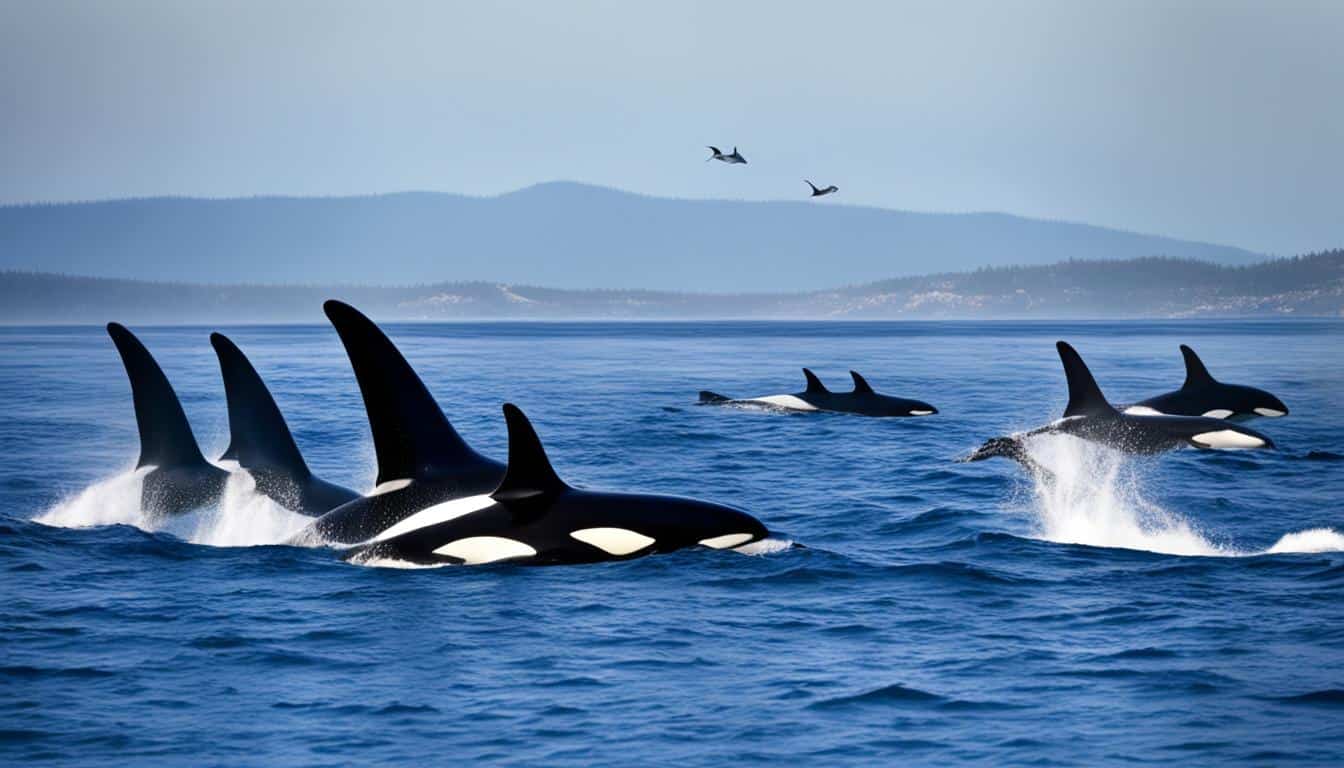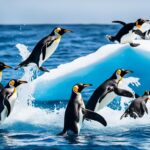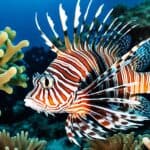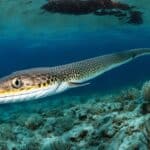Orcas, also known as killer whales, are amazing creatures of the sea. They are key players in marine ecosystems because of how they interact with other sea life. You might ask, how do orcas interact with other marine life? Their social behavior is quite complex, making them very interesting to study.
In this article, we will look into their social structures, hunting ways, and how they communicate. We’ll see how these creatures affect marine life and conservation efforts.
Understanding Orca Social Behavior
Orcas show amazing social complexity, proving their smartness and flexibility. They live in groups with unique behaviors and ways of interacting. Knowing about the different orca pods helps us see how they live and survive together.
The Complex Social Structures of Orcas
Orcas form matrilineal family groups, key to their social setup. These groups, or pods, range from two to 15 members, sometimes gathering in larger groups for hunting or moving together. Their social life is all about working together, forming strong bonds, and learning from each other over time. Each pod has its own way of talking to each other, which helps keep their family ties strong.
Types of Orca Pods and Their Dynamics
There are different kinds of orca pods, each adding to their diversity and ability to adapt. The main types are Residents, Transients, and Offshores, each with its own way of being. Let’s explore what makes each type special:
| Ecotype | Characteristics | Behavior and Diet |
|---|---|---|
| Residents | Stable matrilineal pods, known for complex social structures | Primarily fish eaters, with specific hunting techniques |
| Transients | Smaller pods, more fluid social relationships | Primarily hunt marine mammals, showing sophisticated hunting tactics |
| Offshores | Less understood, often found in deeper waters | Diverse diet potentially includes sharks and other fish |
Learning about orca social behavior and the various orca pods shows us how smart and complex these creatures are. They navigate their social lives in amazing ways in their natural world.
How do orcas interact with other marine life?
Orcas have complex and dynamic interactions with many marine creatures. They show a mix of predatory and friendly behaviors. These interactions help us understand their role in the ocean.
Predatory Relationships with Marine Mammals
Orcas are top predators, hunting a variety of marine mammals. They go after seals, dolphins, and whales. Their hunting is well-planned, helping them catch fast or big prey. This affects the health of the ocean and the numbers of other sea animals.
Non-Predatory Interactions and Coexistence
Orcas also have friendly interactions with other sea creatures. They show curiosity and even play with dolphins and other animals. These friendly moments show how orcas can live with other species. This adds to the diversity of life in the ocean.
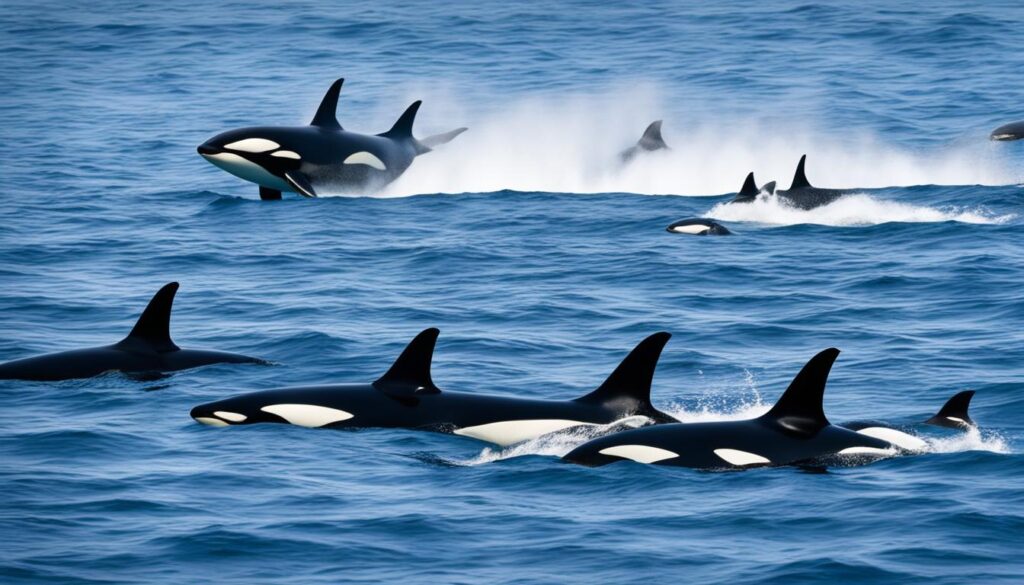
| Interaction Type | Description | Examples |
|---|---|---|
| Predatory | Involves hunting and capturing prey | Orcas hunting seals, knocking seals off ice |
| Non-Predatory | Interactions that do not involve hunting | Orcas swimming alongside dolphins, socializing |
| Coexistence | Relationships where species live together | Orcas and smaller cetaceans sharing habitats |
Orca Hunting Techniques
Orcas are famous for their smart hunting ways. They work together with their pod for better results. This teamwork helps them catch bigger and faster prey more easily. Let’s look at how they hunt.
Cooperative Hunting Strategies within Pods
Cooperative hunting is key to their success. They use many tactics, such as:
- Synchronized swimming to surround prey
- Using echolocation to find hidden fish or mammals
- Coordinating dives to ambush targets effectively
This shows how orcas work together. They can communicate and act as one in amazing ways.
Different Feeding Habits Across Orca Ecotypes
Each type of orca eats differently. Resident orcas mainly eat fish, like salmon, with precise methods. Transient orcas go after marine mammals, using bold tactics. Offshore orcas change their hunting based on what’s available.
Orca Communication with Other Marine Species
Orcas have a complex way of talking to other sea creatures. They use sounds like clicks, whistles, and pulsed calls. These sounds help them hunt together, form social bonds, and share info about their world.
Vocalizations and Their Importance in Interactions
Orcas make sounds that are important for their everyday life. Each group of orcas has its own special sounds. These sounds are passed down through generations, helping young orcas know their group’s calls.
This way of sharing sounds is key for keeping their groups strong and working well together. It helps them stay connected and communicate clearly within and between groups.
Examples of Communication with Dolphins
Orcas also talk to other sea animals, like dolphins. They can swim together and make sounds in sync. This can help them hunt together or just hang out.
They can change how they communicate with dolphins, showing how connected marine life is. This flexibility helps them work well with dolphins and other sea creatures.
Orca Prey Selection and Ecosystem Impact
Orcas have a wide range of food choices that change with different groups and types. Knowing what orcas eat helps us understand their role in the ocean. For example, resident orcas mainly eat fish like Chinook salmon, which is important for the local fish population. On the other hand, transient orcas eat marine mammals, which changes the balance of species in their area.
Diversity of Prey within Different Orca Populations
What orcas eat affects the ocean’s balance. Resident orcas help keep fish populations stable by eating fish. Transient orcas eat marine mammals, which helps manage their numbers. This difference keeps the ocean’s ecosystem balanced and shows how orcas adapt and play a big role in the ocean.
Indirect Effects of Orca Predation on Marine Ecosystems
Orcas’ hunting has big effects on the ocean that go beyond just their prey. Their presence changes how their prey behaves, lives, and reproduces. This affects the entire food chain. As top predators, orcas are key to keeping the ocean healthy and full of life, showing how connected marine life is.
FAQ
How do orcas interact with other marine life?
Orcas, also known as killer whales, have complex interactions with other sea creatures. They hunt and forage in various ways. This affects the numbers of their prey and keeps their habitats in balance.
What are the complex social structures of orcas?
Orcas form matrilineal family groups called pods, with sizes from two to 15 members. These pods have their own social rules and ways of communicating. They use special sounds to talk to each other.
How do different types of orca pods function?
There are different kinds of orca pods, each with its own social setup and role in the ocean. For instance, some pods mainly eat fish, while others hunt marine mammals. Their social structures affect how they hunt and live in their environment.
What are the hunting techniques employed by orcas?
Orcas hunt together using clever strategies. These methods change based on the type of pod. Residents mostly eat fish, while Transients hunt marine mammals aggressively.
How do orcas communicate within their pod and with other marine species?
Orcas use clicks and whistles to talk to each other and hunt together. Each pod has its own set of sounds. These sounds show their unique behaviors and how they pass on traditions.
What is the dietary preference of orcas and how does it affect ecosystems?
Orcas eat different things based on their type. Residents mostly eat fish like Chinook salmon. Transients hunt marine mammals. Their eating habits can change the balance of life in the ocean.
Do orcas interact with sharks?
Yes, orcas sometimes eat sharks. This shows they are at the top of the ocean’s food chain. It also helps control shark numbers in their homes.

